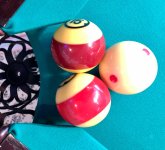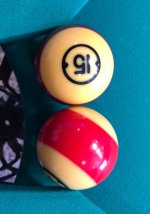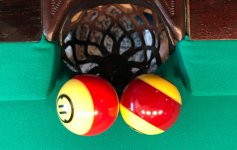I don’t want buckets but I don’t want this extreme eitherI'm into the precision. Buckets are uninspiring and not even fun to shoot at. Running the ball like a wizard is another detriment.
You are using an out of date browser. It may not display this or other websites correctly.
You should upgrade or use an alternative browser.
You should upgrade or use an alternative browser.
GB9 Ball Tour Tight pockets
- Thread starter skor
- Start date
What about a player that only plays in the US on easy tables and not facing that many European players?Fargo Ratings don't in a sense "react" to the difficulty of the equipment the way you are thinking. The balance between US and European ratings is determined by the aggregate of what happens when US players play European players. This includes situations in which the US and European players are on easy equipment and other situations in which they are on hard equipment. Importantly, though, the two players in each game are always on the SAME equipment.
Whether practicing or competing on easier equipment is good or bad for player development is a different question, and a nuanced one.
I’m sure that most of the 700 and under players probably fit here.
This is what 4 1/4” CP look like and that what I play on 80% of the time. The other 20% is 4 1/2” CP on 7’ & 9’ tables.Sorry thats what i meant, clash steel.your definitely right on the tournament tables. This is what i read:
View attachment 834091
IMO, the pockets think the CP look like 4 1/8” but without placing the OBs side by side it is hard to distinguish size.
Attachments
There is more to the playability of a table than the pocket opening size.
the geometry and slate depth play a major part.
On a match snooker table, it is very hard to pocket a ball if it touches the cushion before the angle of the pocket, even on a tight Diamond table, balls hitting the rail a foot from the pocket can go in.
the geometry and slate depth play a major part.
On a match snooker table, it is very hard to pocket a ball if it touches the cushion before the angle of the pocket, even on a tight Diamond table, balls hitting the rail a foot from the pocket can go in.
Long time ago - really long time - I quit wasting time chasing the superior part of the field and stuck to the real stuff - the pool, It's all win there.I don’t want buckets but I don’t want this extreme either
Consider two players:What about a player that only plays in the US on easy tables and not facing that many European players?
I’m sure that most of the 700 and under players probably fit here.
Greg is a US player rated 670 who plays almost exclusively on easy tables
Johan is a European player rated 670 who plays almost exclusively on tight tables
What does that mean that they are rated the same?
It means they have the same SKILL in a broader sense than just proficiency playing a particular game on a particular table. If Johan visited Greg and they played on the easy equipment, Greg would probably win. But it is not because Greg is a better player. It is because Johan suffers from unfamiliarity with the conditions. Same thing in the other direction: If Greg visited Johan and played on the tougher equipment, Johan would probably win.
What is the difference between Greg losing to Johan because of "unfamiliarity" and Greg losing to Johan because of "less skill"? The difference is the response to modest (dozens or hundreds of hours) play. If Greg visited Johan for a month and played against him for a few hours a day on his tough equipment, Greg would be keeping up with Johan by the end. Actual skill is much much harder to change.
Your example might be correct for that particular scenario.Consider two players:
Greg is a US player rated 670 who plays almost exclusively on easy tables
Johan is a European player rated 670 who plays almost exclusively on tight tables
What does that mean that they are rated the same?
It means they have the same SKILL in a broader sense than just proficiency playing a particular game on a particular table. If Johan visited Greg and they played on the easy equipment, Greg would probably win. But it is not because Greg is a better player. It is because Johan suffers from unfamiliarity with the conditions. Same thing in the other direction: If Greg visited Johan and played on the tougher equipment, Johan would probably win.
What is the difference between Greg losing to Johan because of "unfamiliarity" and Greg losing to Johan because of "less skill"? The difference is the response to modest (dozens or hundreds of hours) play. If Greg visited Johan for a month and played against him for a few hours a day on his tough equipment, Greg would be keeping up with Johan by the end. Actual skill is much much harder to change.
But here is a different scenario:
Greg is a 680 player who only plays bar tables with big pockets.
John is a 680 player who only plays 9ft tables with tight pockets.
The players are playing each other in a tournament, let’s say, the US Open. Race to 11. Who will win?
If Fargo rating is used to determine handicap, then it’s a bit off.
I also think that players show different skill level at different games and one rating for all games is not that accurate.
It might give a general idea about the player’s skill level, but I think that it’s given too much weight.
There is, I think, an important thing commonly missed when people analyze easy vs hard equipment. I'll illustrate with a particular scenario. You're playing 9-Ball, and there are 5 balls on the table that are not tied up but you are starting with a long shot. Let's compare this situation on easy and hard tables and imagine your opponent is similarly skilled as you.
Three things can happen when you try to get out from here
A: you succeed
B: You fail and your opponent also fails and returns control of the game to you
C: You fail and your opponent either gets out or retains control of the game
The chance of direct success, i.e., A, can be very different on easy vs hard equipment. It might be 65% on the easy table and 35% on the hard table. It is important not to look at this in isolation, though, and conclude incorrectly that the GAME is easier on easy equipment. Though failure is less likely on the easy equipment, that failure being punished is more likely. And these things kind of balance out.
Easy equipment:
A: 65% chance you succeed
B: 35% that you failed X 35% that your opponent subsequently fails returning control to you (12%)
C: 35% that you failed X 65% that your opponent wins the game or retains control (23%)
Tough equipment:
A: 35% chance you succeed
B: 65% that you failed X 65% that your opponent subsequently fails returning control to you (42%)
C: 65% that you failed X 35% that your opponent wins the game or retains control (23%)
In both cases, you are looking at about a 77% chance of overall success (A or B) and a 23% chance of failure (C). So you should be sweating about the same amount staring at that long shot on either table despite that shot looking easier on the easy table.
So given that your opponent effectively gets better as the equipment gets easier, there is a sense in which the GAME in the bigger picture is pretty independent of the equipment and really depends primarily on your opponent. That's not a bad thing.
Three things can happen when you try to get out from here
A: you succeed
B: You fail and your opponent also fails and returns control of the game to you
C: You fail and your opponent either gets out or retains control of the game
The chance of direct success, i.e., A, can be very different on easy vs hard equipment. It might be 65% on the easy table and 35% on the hard table. It is important not to look at this in isolation, though, and conclude incorrectly that the GAME is easier on easy equipment. Though failure is less likely on the easy equipment, that failure being punished is more likely. And these things kind of balance out.
Easy equipment:
A: 65% chance you succeed
B: 35% that you failed X 35% that your opponent subsequently fails returning control to you (12%)
C: 35% that you failed X 65% that your opponent wins the game or retains control (23%)
Tough equipment:
A: 35% chance you succeed
B: 65% that you failed X 65% that your opponent subsequently fails returning control to you (42%)
C: 65% that you failed X 35% that your opponent wins the game or retains control (23%)
In both cases, you are looking at about a 77% chance of overall success (A or B) and a 23% chance of failure (C). So you should be sweating about the same amount staring at that long shot on either table despite that shot looking easier on the easy table.
So given that your opponent effectively gets better as the equipment gets easier, there is a sense in which the GAME in the bigger picture is pretty independent of the equipment and really depends primarily on your opponent. That's not a bad thing.
Im all for tighter pockets, but sub-4inch is a bit much I think... not to mention the open pocket facings... that looks miserable.


